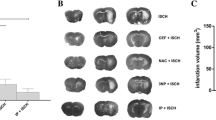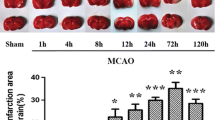Abstract
This study was performed to determine whether exogenous N-methyl-d-aspartate (NMDA) or alpha-amino-3-hydroxy-5-methyl-4-isoxazole propionic acid (AMPA) would aggravate blood–brain barrier (BBB) disruption in focal cerebral ischemia in rats. Forty-five minutes after middle cerebral artery (MCA) occlusion, one of the following patches was applied to the exposed ischemic cerebral cortex of each rat: normal saline (control), 10−5 M AMPA, 10−4 M AMPA, 10−5 M NMDA, or 10−4 M NMDA. At 1 h after MCA occlusion, BBB permeability was determined by measuring the transfer coefficient (Ki) of 14C-α-aminoisobutyric acid (14C-AIB). In all experimental groups, the Ki of the ischemic cortex (IC) was higher than that of the corresponding contralateral cortex (CC). The Ki of the IC of the animals treated with 10−4 M AMPA or 10−4 M NMDA was higher (+41%: P < 0.05 and +33%: P < 0.05, respectively) than that of the control animals. Our data demonstrated that exogenous NMDA or AMPA could further aggravate the BBB disruption in focal cerebral ischemia. Any insult increasing the release of excitatory neurotransmitters could further aggravate BBB disruption and brain edema during the ischemic period.


Similar content being viewed by others
References
Ritz MF, Schmidt P, Mendelowitsch A (2004) Acute effects of 17beta-estradiol on the extracellular concentration of excitatory amino acids and energy metabolites during transient cerebral ischemia in male rats. Brain Res 1022:157–163. doi:10.1016/j.brainres.2004.07.004
Umemura K, Gemba T, Mizuno A et al (1996) Inhibitory effect of MS-153 on elevated brain glutamate level induced by rat middle cerebral artery occlusion. Stroke 27:1624–1628
Mayhan WG, Didion SP (1996) Glutamate-induced disruption of the blood–brain barrier in rats. Role of nitric oxide. Stroke 27:965–969 discussion 970
Sharp CD, Hines I, Houghton J et al (2003) Glutamate causes a loss in human cerebral endothelial barrier integrity through activation of NMDA receptor. Am J Physiol Heart Circ Physiol 285:H2592–H2598
Stevens MK, Yaksh TL (1990) Systematic studies on the effects of the NMDA receptor antagonist MK-801 on cerebral blood flow and responsivity, EEG, and blood–brain barrier following complete reversible cerebral ischemia. J Cereb Blood Flow Metab 10:77–88
Albayrak S, Zhao Q, Siesjo BK et al (1997) Effect of transient focal ischemia on blood–brain barrier permeability in the rat: correlation to cell injury. Acta Neuropathol 94:158–163. doi:10.1007/s004010050688
Chi OZ, Hunter C, Liu X et al (2005) Effects of VEGF and nitric oxide synthase inhibition on blood–brain barrier disruption in the ischemic and non-ischemic cerebral cortex. Neurol Res 27:864–868. doi:10.1179/016164105X49418
Andras IE, Deli MA, Veszelka S et al (2007) The NMDA and AMPA/KA receptors are involved in glutamate-induced alterations of occludin expression and phosphorylation in brain endothelial cells. J Cereb Blood Flow Metab 27:1431–1443. doi:10.1038/sj.jcbfm.9600445
St’astny F, Schwendt M, Lisy V et al (2002) Main subunits of ionotropic glutamate receptors are expressed in isolated rat brain microvessels. Neurol Res 24:93–96. doi:10.1179/016164102101199468
Dempsey RJ, Baskaya MK, Dogan A (2000) Attenuation of brain edema, blood–brain barrier breakdown, and injury volume by ifenprodil, a polyamine-site N-methyl-d-aspartate receptor antagonist, after experimental traumatic brain injury in rats. Neurosurgery 47:399–404. doi:10.1097/00006123-200008000-00024 discussion 404-396
Germano A, Caffo M, Angileri FF et al (2007) NMDA receptor antagonist felbamate reduces behavioral deficits and blood–brain barrier permeability changes after experimental subarachnoid hemorrhage in the rat. J Neurotrauma 24:732–744. doi:10.1089/neu.2006.0181
Yang G, Chan PH, Chen SF et al (1994) Reduction of vasogenic edema and infarction by MK-801 in rats after temporary focal cerebral ischemia. Neurosurgery 34:339–345. doi:10.1097/00006123-199402000-00018 discussion 345
Chi OZ, Chang Q, Weiss HR (1997) Effects of topical N-methyl-d-aspartate on blood–brain barrier permeability in the cerebral cortex of normotensive and hypertensive rats. Neurol Res 19:539–544
Westergren I, Johansson BB (1993) Blockade of AMPA receptors reduces brain edema following opening of the blood–brain barrier. J Cereb Blood Flow Metab 13:603–608
Westergren I, Johansson BB (1992) NBQX, an AMPA antagonist, reduces glutamate-mediated brain edema. Brain Res 573:324–326. doi:10.1016/0006-8993(92)90781-4
Gross PM, Blasberg RG, Fenstermacher JD et al (1987) The microcirculation of rat circumventricular organs and pituitary gland. Brain Res Bull 18:73–85. doi:10.1016/0361-9230(87)90035-9
Koenig H, Trout JJ, Goldstone AD et al (1992) Capillary NMDA receptors regulate blood–brain barrier function and breakdown. Brain Res 588:297–303. doi:10.1016/0006-8993(92)91589-7
Chi OZ, Wei HM, Sinha AK, Weiss HR (1994) Effects of inhibition of nitric oxide synthase on blood–brain barrier transport in focal cerebral ischemia. Pharmacology 48:367–373. doi:10.1159/000139202
Nag S (1991) Protective effect of flunarizine on blood–brain barrier permeability alterations in acutely hypertensive rats. Stroke 22:1265–1269
Nag S (1992) Vascular changes in the spinal cord in N-methyl-d-aspartate-induced excitotoxicity: morphological and permeability studies. Acta Neuropathol 84:471–477. doi:10.1007/BF00304465
Lu X, Sinha AK, Weiss HR (1997) Effects of excitatory amino acids on cerebral oxygen consumption and blood flow in rat. Neurochem Res 22:705–711. doi:10.1023/A:1027354110563
Johansson BB, Westergren I (1994) Pharmacological reduction of brain edema induced by intracarotid infusion of protamine sulphate: a comparison between a free radical scavenger and an AMPA receptor antagonist. Acta Neurochir Suppl (Wien) 60:128–131
Matute C, Gutierrez-Igarza K, Rio C et al (1994) Glutamate receptors in astrocytic end-feet. NeuroReport 5:1205–1208. doi:10.1097/00001756-199407000-00012
Chi OZ, Chang Q, Wang G et al (1999) A nonNMDA antagonist, GYKI 52466 improves microscopic O2 balance in the cortex during focal cerebral ischemia. Neurol Res 21:299–304
Narayanan U, Chi OZ, Liu X et al (2000) Effect of AMPA on cerebral cortical oxygen balance of ischemic rat brain. Neurochem Res 25:405–411. doi:10.1023/A:1007505507532
Author information
Authors and Affiliations
Corresponding author
Rights and permissions
About this article
Cite this article
Chi, O.Z., Hunter, C., Liu, X. et al. Effects of Exogenous Excitatory Amino Acid Neurotransmitters on Blood–Brain Barrier Disruption in Focal Cerebral Ischemia. Neurochem Res 34, 1249–1254 (2009). https://doi.org/10.1007/s11064-008-9902-7
Accepted:
Published:
Issue Date:
DOI: https://doi.org/10.1007/s11064-008-9902-7




